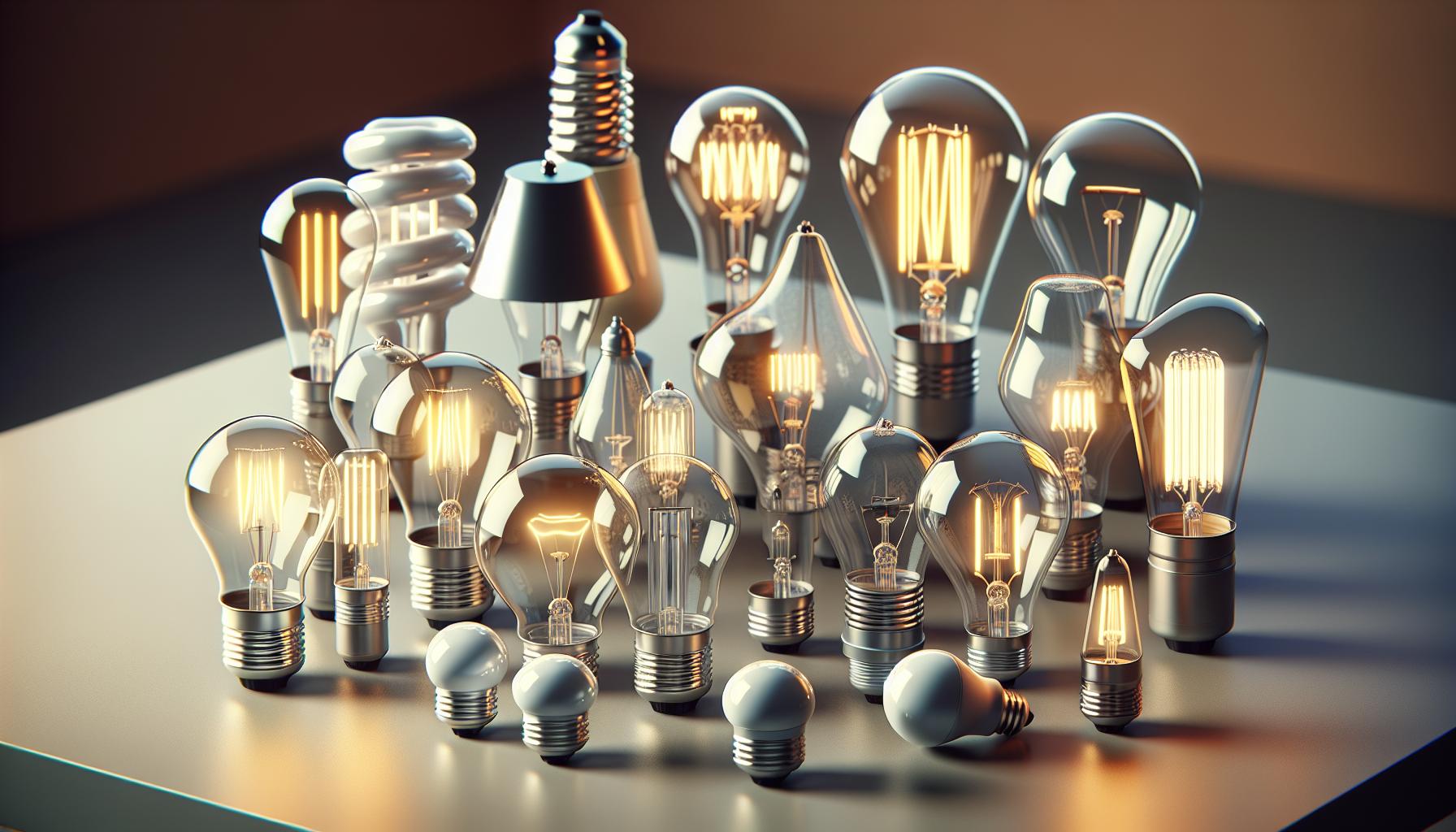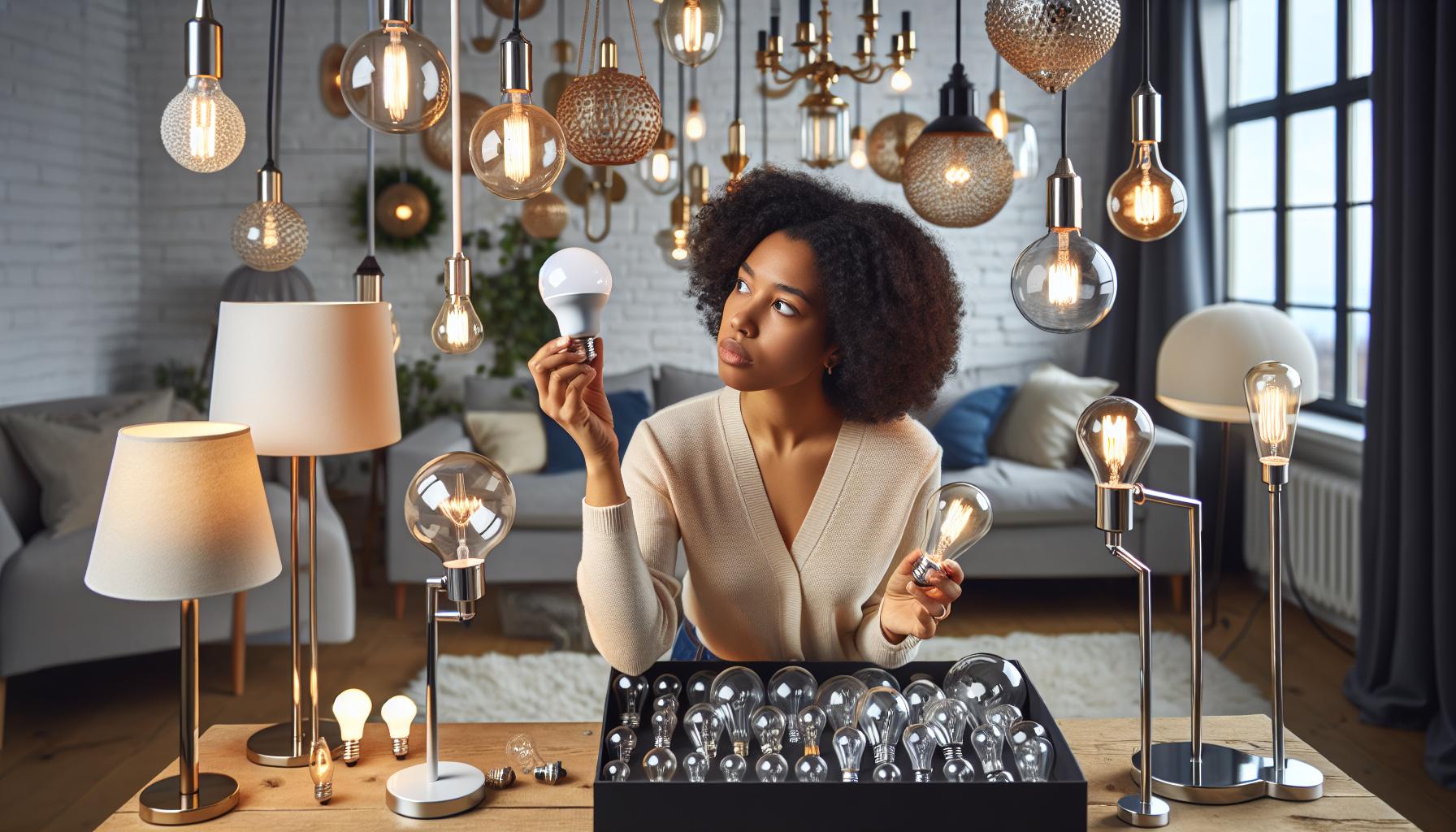Ever found yourself staring at an overwhelming array of light bulbs in the hardware store, wondering which size fits your lamp at home? You’re not alone. Choosing the right light bulb size can be surprisingly tricky, but it’s crucial for that perfect fit and ambiance.
Don’t worry, figuring out the mystery behind bulb sizes is easier than you think. In the next few minutes, you’ll learn how to quickly identify the right bulb size for any fixture. Say goodbye to guesswork and hello to a well-lit space that’s just right.
The Importance of Choosing the Right Light Bulb Size
When you’re in the midst of planning your home’s lighting layout, size really does matter. Sure, the wattage and color temperature are critical to setting the mood, but the actual physical dimensions of your light bulbs can make or break the functionality and aesthetics of your lighting fixtures. It’s like finding the perfect pair of jeans; it just feels right when the fit is spot on.
Light bulbs come in a veritable smorgasbord of shapes and sizes, from the petite candle-like bulbs that add just a touch of whimsy to a chandelier, to the large, globe-style bulbs that command attention in modern decor. But it’s not just about looks. Choose a bulb that’s too big, and it might not fit your fixture at all, leaving you in a dark and frustrating situation. A bulb that’s too small could look out of place or fail to provide the kind of illumination necessary for the space.
Let’s talk fixtures. A well-suited bulb complements the design of your fixture and ensures it operates at its best. For example, a tight, enclosed fixture needs a bulb that can handle the heat, as it’ll run hotter than a bulb in an open-air setting. Your choice also impacts the fixture’s light distribution. A larger bulb in a table lamp could produce an asymmetrical light pattern, casting shadows where you least want them.
When you’re on the hunt for the right size bulb, bypass the guesswork by checking the fixture’s manual or manufacturer’s website. They typically list the maximum dimensions or specific bulb sizes that are compatible. If that information isn’t available, bring the old bulb with you when you go shopping, or measure the dimensions of your fixture’s opening and compare them against the bulb size specifications you’re considering.
Remember, the right light bulb size is vital to achieving a well-lit and harmonious home. With a little attention to detail, you’ll illuminate every corner of your abode with confidence and style.
Understanding Light Bulb Sizing Terminology
When you’re tackling a new home DIY project or giving your lighting a fresh update, knowing your light bulb sizing terminology is crucial. Grasping the basics will not only streamline your project but also ensure that you get the perfect fit every time.
Bulb shapes are usually represented by a series of letters and numbers. These aren’t randomly chosen; they’re the manufacturers’ way of telling you about the shape and size of the bulb. For example, an ‘A19’ bulb is the classic shape most people think of when they imagine a light bulb – the ‘A’ signifies the shape (arbitrary) and the ’19’ refers to the diameter at the bulb’s widest point in eighths of an inch. So, A19 means the bulb is 2 and 3/8 inches wide.
Here’s a quick guide to some common bulb shapes:
- A (Arbitrary)
- B (Bullet)
- C (Candle)
- G (Globe)
- R (Reflector)
- PAR (Parabolic Aluminized Reflector)
But it’s not just shape you need to consider. You’ll also come across terms like ‘lumens’ and ‘watts’. Lumens measure the amount of light the bulb emits, while watts tell you how much energy it uses. Looking for high lumen output with low wattage will lead you to energy-efficient bulbs that are kind to both your wallet and the environment.
For base types, common ones include the Edison screw base, often denoted by ‘E’, followed by a number which corresponds to the base diameter in millimeters. Many household lamps use E26 base bulbs, which means they have a 26 mm diameter screw base.
Don’t forget to consider the color temperature of a bulb, indicated in Kelvin (K). A lower Kelvin means a warmer, more incandescent-like glow, while a higher Kelvin gives off a cooler, daylight-like light. This can drastically affect the ambiance of a room.
| Term | Meaning | Example |
|---|---|---|
| Lumens | Light output | 800 lm |
| Watts | Energy used | 60 W |
| Kelvins | Color Temperature | 2700 K – |
Common Light Bulb Sizes and Their Applications
« What Happens to Light Bulbs in a Fire: Surprising Truths Revealed
When Do Light Bulbs Explode? Shocking Reasons & Safety Tips »
You’ll find that light bulbs come in a variety of sizes and each has its own appropriate setting. Knowing which bulb to use can make all the difference in your DIY lighting projects.
A19 bulbs are your standard light bulb size for most residential applications. They fit in your typical table lamps, ceiling fixtures, and porch lights. Their average diameter is about 2.375 inches, making them versatile for general use around your home.
For smaller fixtures like wall sconces or decorative lamps, B11 bulbs, often referred to as candelabra bulbs, are the go-to. Their slender shape and petite size imbue a cozy, yet sophisticated air to your space.
Workspace lighting, such as under-cabinet or desk lamps, usually requires T10 bulbs. These tubular bulbs provide a concentrated beam of light, perfect for detailed tasks and highlighting specific areas without overwhelming the entire room.
In recessed lighting or track lighting, the PAR30 and BR30 bulbs shine. These abbreviations stand for Parabolic Aluminized Reflector and Bulged Reflector, respectively. The difference lies in their beam angles – PAR30s offer a focused beam, ideal for accentuating artwork or architectural features, whereas BR30s offer a broader light distribution, bathing your space in a warm, even glow.
Here’s a quick reference guide to common light bulb sizes:
| Bulb Type | Common Use | Diameter |
|---|---|---|
| A19 | Standard home fixtures | 2.375 inches |
| B11 | Decorative fixtures, chandeliers | 1.38 inches |
| T10 | Task lighting, under-cabinet | 1.25 inches |
| PAR30 | Accent, outdoor, and track lighting | 3.75 inches |
| BR30 | Recessed and general lighting | 3.75 inches |
Remember, when you’re out shopping for bulbs, it’s not just finding the right fit physically, but also ensuring that the light it emits serves your intended use. Whether you’re creating an inviting atmosphere, highlighting a prized piece of art, or simply illuminating a workspace, there’s a bulb size that’s tailored for the task at hand. Keep your fixture’s function in mind as much as its form.
How to Determine the Size of Your Current Light Bulb
You’re on the hunt for the perfect light bulb, but first, you need to figure out what size you’ve got in your fixture. It’s like detective work for your home’s lighting, and it’s pretty straightforward once you know what to look for.
First things first, safety is paramount. Ensure the light switch is off and the bulb is cool to the touch before you remove it from the fixture. Once you’ve got the bulb in hand, look for any markings or labels that might indicate its size. Manufacturers often print the size code directly on the bulb’s base or side.
But what if there’s no label? No worries—you’ve got this. Light bulb sizes are typically referenced by a letter that indicates the shape followed by a number that represents the diameter at the bulb’s widest point in one-eighth inch increments. For example, an A19 bulb is an ‘A’ shape and approximately 19 eighths of an inch (or 2 and 3/8 inches) in diameter.
Here’s a quick rundown to measure the bulb:
- Roll out a measuring tape or ruler
- Measure the diameter of the bulb’s widest point
- Convert this measurement to eighths to find your bulb’s size code
Alternatively, compare your bulb with the common sizes mentioned previously, such as A19 or PAR30. This visual check is sometimes all you need to figure out the right match for your fixture.
If DIY is your jam, you might enjoy creating a template. Cut out circles in cardboard to represent sizes like A19, B11, etc. Slip these templates over your bulb to see which fits best. It’s not only a practical solution but also a nifty little project.
Remember, the right bulb size maximizes efficiency and sets the mood just right. So, it’s worth taking the time to measure and compare to light up your space perfectly. Who knew that working with watts and lumens could also involve a mini math workout?
Tips and Tricks for Choosing the Right Light Bulb Size
When you’re on the hunt for the perfect light bulb, it’s like searching for that missing puzzle piece. It has to be just right or the whole picture won’t come together. Luckily, I’ve got a few trade secrets that’ll make choosing the right light bulb size a breeze.
Firstly, start by considering the purpose of the light. Is it for your cozy reading nook or to brighten up the entire living room? Different activities require different types of lighting. Ambient light might need larger bulbs with widespread illumination, whereas task lighting is better with small, more focused bulbs.
Keep your fixture type in mind. Various fixtures are designed for specific bulb sizes; hence, flick through the manufacturer’s manual. It’s not just homework; it’s a cheat sheet to lighting success. If you no longer have the manual, most details can typically be found online with a simple search of your fixture’s make and model.
Here’s a quick hack: take a photo of your fixture and have it handy while shopping. This way, you can visualize how different bulb sizes might fit and appear in your space. Plus, it can help the store staff give you targeted advice.
What about the base of the bulb? Ensure it matches your fixture by comparing the base type and size. Common base types include screw bases (E26/E27) and pin bases (GU10 or MR16), each fitting into particular sockets.
- If you’re lost, here’s a brief guide:
Finally, don’t forget to look at the watts. The bulb’s wattage isn’t just about brightness—it affects energy consumption. If you’re going LED, remember they offer similar brightness at lower wattages compared to traditional bulbs.
With these tips in mind, you’ll zero in on the ideal bulb size in no time. Have your workspace feeling like a tech haven, or your bedroom lit for peak relaxation—all it takes is a bit of know-how and that eye for DIY you’ve perfected over the years. Keep up the great work, and light up your space just the way you dream it to be.
Conclusion
Armed with these insights, you’re now equipped to navigate the world of light bulbs with confidence. Remember, matching the bulb to both the purpose and fixture is key to finding your perfect fit. Snap that photo, compare the bases, and don’t forget to check the wattage. With a little attention to detail, you’ll illuminate your space exactly as you envision. Happy lighting!
Frequently Asked Questions
What factors should I consider when choosing the right light bulb size?
When selecting a light bulb size, consider the bulb’s purpose and the type of light fixture. The size needs to match the fixture for proper function and aesthetics.
How can I ensure the new bulb will fit into my fixture?
Take a photo of the fixture and compare it with potential bulbs, focusing on base type and size to ensure compatibility.
What are the main types of light bulb bases I should know about?
The two main types of light bulb bases are screw bases and pin bases. Each base type comes in various sizes, so it’s essential to match the base to your fixture.
Why is it important to consider bulb wattage when selecting a size?
Bulb wattage is important because it determines the energy consumption and light output. Ensure the bulb’s wattage is suitable for your fixture and meets your lighting needs.





